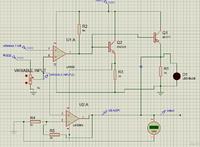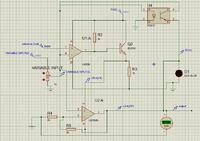Follow along with the video below to see how to install our site as a web app on your home screen.
Note: This feature may not be available in some browsers.
there is no problem in amplifying it . i need to amplfy every signal below 1 volt . please give example for level detector circuitsBTW, what happens if your input is 750mV? 100mV?
@mshh
You can use precision amplifier like AD620 to achieve that, what I understand is that you need to amplify 130mV to 500mV signal(this means gain of 3.84) and amplify 1V to 10v signal(this means gain of 10)
there is no problem in amplifying it . i need to amplfy every signal below 1 volt . please give example for level detector circuits
it is DC signal the source give mv and in other times give greater than 1 volt i did this circuit using comparator and npn -pnp transistors . then the output is gathered from both , absolutely one of them will give output. what do you say?A simple voltage comparator. But you tell us nothing about your signal. Is it 400 Ghz? Is it DC?


Not without added compensation. The comparator does not have the internal compensation that an opamp has to prevent oscillations in a closed loop circuit..............................
could i use this lm339 comparator as an amplifier instead of lm 358 opamp?
no 1v is very big offset , what is the problem with my circuit?Below is the simulation of an amp that provides a gain of 2 up to about 2V output and then transitions to a gain of one. The one possible disadvantage to this simple circuit is that there is about a 1V offset to the output for inputs above 1V.
i don't want to monitor the gain but i want to use gain in a range and other gain in different range this is just the function that i want to do.The problem with any circuit that switches gain is that the input cannot be determined unambiguously from the output unless you also know when it switches the gain. Do you intend to monitor when the gain is switched?
what do you mean by sketching transfer function ? you get what i want to do.To avoid further fruitless tries of yourself and misunderstandings of forum members, please start with sketching the intended transfer function.